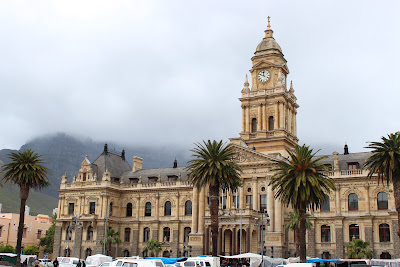Heading East from the Cape we headed to Hermanus, known for being the best land-based whale watching in the world, and then on to Franschhoek in the wine lands, known for being the undisputed gastronomic capital of South Africa (settled by the French of course!). So in summary - after whale watching, we then went on to eat enough food to become actual whales.
Hermanus (originally called Hermanuspietersfontein, but shortened as the name was too long for the postal service - can't see why), is a town with 49,000 inhabitants on the southern coast of the Western Cape province of South Africa. It is famous for watching southern right whales during the southern winter and spring. And boy do those whales not disappoint. I've been whale watching many times in my life and I have never seen anything like this. The whales are pretty much exclusively mothers and calves, and there is only one natural predator that can take out a southern right whale calf - a great white shark, who has it happens is also in the neighborhood (more on them later). So in order to keep the babies safe the mothers bring them almost to land where they sit in the shallow surf beyond the reach of an ambush predator like the GWS.
For those of us even with the feeble naked eye, it's no trouble at all to simply stand on the beach and watch whale after whale breech, or slap the surface with their mighty fins and tails. It's truly a magical experience.
Hermanus (originally called Hermanuspietersfontein, but shortened as the name was too long for the postal service - can't see why), is a town with 49,000 inhabitants on the southern coast of the Western Cape province of South Africa. It is famous for watching southern right whales during the southern winter and spring. And boy do those whales not disappoint. I've been whale watching many times in my life and I have never seen anything like this. The whales are pretty much exclusively mothers and calves, and there is only one natural predator that can take out a southern right whale calf - a great white shark, who has it happens is also in the neighborhood (more on them later). So in order to keep the babies safe the mothers bring them almost to land where they sit in the shallow surf beyond the reach of an ambush predator like the GWS.
For those of us even with the feeble naked eye, it's no trouble at all to simply stand on the beach and watch whale after whale breech, or slap the surface with their mighty fins and tails. It's truly a magical experience.
We actually had this baby right whale come up and bump our boat (they are only white when they are really young). It was fantastic.
Mother and baby cruising along.
Waving bye?
This is the famous Seal Island, home to over 40,000 cape fur seals. It is also the site of the Planet Earth footage of the GWS leaping out of the water to make a meal out of these guys. Consider it a shark buffet.
Did you say shark? I want to see one! What's that the water is 50 degrees? Ok, lets make this quick.
So of course we had to get into the water with the GWS. Cage diving! This male is just a juvenile.
Matt was pretty committed to getting this video in spite of a scratched lens and poor visibility. Luckily our friendly shark made it pretty easy to capture him on camera.
Matt was pretty committed to getting this video in spite of a scratched lens and poor visibility. Luckily our friendly shark made it pretty easy to capture him on camera.
Nothing like celebrating your survival of the cage diving experience with a few bubbles and more whale watching (they are in the water right behind Matt).
Not a bad way to spend your 33rd birthday!
Now off to dive into a bottle of wine, rather than a shark cage.
The scenery at Jordan Winery was beautiful, and made all the more charming by the resident population of chameleons.
Let the calorie loading begin!
Yeah, you don't need a birthday cake when you have the world's best souffle.
And we actually spotted one! I love the color scheme.
With the seasons inverted from the northern hemisphere, spring was in full effect in South Africa. These little fuzzies where to cute for words.
Trying out the house vintage at the Auberge Clermont, our home for two nights.
We also took the opportunity to horse back riding between the vineyards. No officer, I'm not sober but my horse is!
The scenery surround the vines was stunning.
We were treated to a beautiful sunset amongst the vines.
Matt fell in love with his all white mare. Thankfully she doesn't fit in a carry on.
Did I mention the food?
This salmon three ways was a standout.
After an afternoon of rain, we lucked out with this final sunset. It was spectacular!





















.JPG)





.JPG)


















